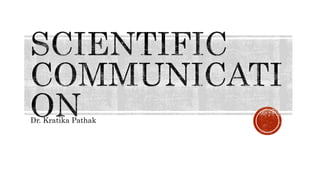
Scientific Communication.pptx
- 2. Science communication describes a variety of practices that transmit scientific ideas, methods, knowledge and research to non-expert audiences in an accessible, understandable or useful way.
- 3. Science Outreach: This is led by scientists and addressed to non-expert audiences; it includes information, dialogue, and involvement with the stakeholders. Inputs for successful science outreach are: • Research; • Evaluation; • Leadership programs; • Institutional support for scientists and publics; • Strategy of communication. Activities should include: • Public dialogue approaches; • Knowledge co-production approaches Science Inreach/ Scholarly Communication: This is an expert-to-expert communication, either with the same scientific background or different ones. This approach would support successful scientific collaboration in several ways, including: • Help groups identify and articulate shared interests; • Set models for working together; • Ensure that all members of a community could participate and have their input.
- 4. FORMS OF SCIENCE COMMUNICATION 1.Science Journalism is one-way communication, which means there is no interaction with the public. Mediums included in this type of communication are the internet, newspapers, magazines, TV, and radio. 2.Science Museums and Science Centers are hubs of scientific knowledge that stimulate curiosity and expose children and adults to hands-on science experiments. Those that have been working on re-inventing themselves help people cope with the quickly changing technological environment, which could lead to improving their life skills. These places encompass science exhibitions, with hands-on exhibits, interactive displays, open labs, public lectures, and science shows. 3.Live or Face-to-Face Events allow a two-way dialogue between scientists and the public. During these events, the audience can participate with questions, insights, and experiences. 4.Citizen Science; citizen scientists are active contributors to the science field. They can participate in research through collecting data and participating in scientific projects with professionals. 6.Science Festivals provide science with more freshness and glam to attract the general public. These festivals are also dedicated to bringing researchers closer to the public; they showcase the diversity of research and highlight the impact of research on our daily lives. 7.Children’s Universities are programs that typically include science-related lectures, workshops, hands-on tutorials, or similar activities, which take place as summer programmers, after-school activities, or at weekends.
- 5. Research papers Research papers are a fundamental component of scientific communication, and the primary way scientists share their research findings with their peers and the broader scientific community. Research papers can be anywhere from 5-50 pages in length, depending on the complexity of the subject matter. The structure of research papers can vary depending on the discipline and the journal's requirements. However, most research papers will include • Abstract. This should be a brief summary of the research question, method, results, and conclusion., You should write this last as an overview of your research paper. • Introduction. This section should provide background to the research questions, including any prior research, a literature review, and the study’s objectives. • Methods. This section describes the study’s design, research sample, and data collection methods. • Results. This should include your findings and any data analysis, figures, tables, and graphs. • Discussion. Here you should interpret the results, including their significance, limitations, and implications for future research, • Conclusion. Here you should summarize the key findings, state whether your research questions were answered, and comment on the importance of any findings. Research papers are typically published in academic journals and provide a detailed account of a particular research project or study. They are a key aspect of working in the life science industry and should be more formal in tone.
- 6. Scientific Blog posts Blog posts are an increasingly popular method of scientific communication. They provide an informal and accessible way for scientists to share their research findings, insights, and perspectives with a broader audience. Blog posts should be accessible to your audience and engaging. You should write in a clear and conversational style. Be sure to include anecdotes, examples, and high- quality images to increase readability. Blogging helps scientists connect with the public, promote research, and engage in scientific discussions. You can seamlessly weave a high number of keywords into a blog post. This will improve your website’s google ranking and help drive organic website traffic!
- 7. Scientific White pages White papers are a type of scientific communication used to illustrate a solution to a problem within a scientific industry. Individual scientists or groups of scientists typically use them to demonstrate their knowledge and expertise on a topic through facts and evidence. White papers are typically longer and more detailed than other types of scientific communication, such as blog posts or research papers. They may include data, statistics, case studies to support their arguments, and relevant research and literature references. White papers may also include policy recommendations or proposals for further research. Having a clear and well-defined argument or perspective is important when writing a white paper. The paper should be evidence-based, drawing on data and research to support its claims. The paper should also be well-structured and easy to navigate, with clear headings and subheadings. Social media posts Social media is an accessible tool to help you keep up with the latest news, engage in scientific discussions, and build professional networks. With popular social media apps like LinkedIn, Twitter, Facebook, Instagram, and TikTok at our fingertips, it's no wonder social media is becoming a popular method of science communication. Social media for scientific communication should be professional, engaging, and current. Scientists should avoid sharing confidential information or making unsupported claims. Scientists should also ensure that their social media activity aligns with their brand image and professional values. Nowadays, your social media presence is an extension of you and your research, so creating a strong, authentic brand image is essential.